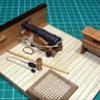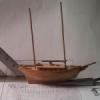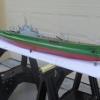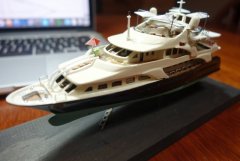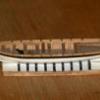Supplies of the Ship Modeler's Handbook are running out. Get your copy NOW before they are gone! Click on photo to order.
×
-
Posts
5,869 -
Joined
-
Last visited
Reputation Activity
-
 BANYAN got a reaction from thibaultron in Tackles With Lots of Rope In Between
BANYAN got a reaction from thibaultron in Tackles With Lots of Rope In Between
Hi Mike, as per Jud and I tend to rig mine off the model first using the vertical (adjustable) part of my rigging station shown below. i adjust this to the right distance apart (just longer than needed), clip the hooks into the alligator clamps (with both block facing the same way - end on or side on) and rig it here before transferring to the ship. If two single blocks, start with the rigging line attached to the heel of the upper block, run to bottom block threading from front to back, up to the top block threading back to front then down to the bottom block. Cut the running end allowing enough to form several loops or coils after belaying. Use a micro clip (see other photo - available from electronics stores) to temp hold the running end to the other parts of the tackle lines. The trick is to ensure you do not twist this setup during transfer
This station (rigging crab) is based on one designed by the late Hubert Sicard (Wooden Ship Modelling for Dummies).
I hope that helps?
-
 BANYAN got a reaction from cog in 74-gun ship by Gaetan Bordeleau - 1:24
BANYAN got a reaction from cog in 74-gun ship by Gaetan Bordeleau - 1:24
Very nicely faired hull Gaetan; you must be happy to moving onto new tasks
cheers
Pat
-
 BANYAN got a reaction from BETAQDAVE in Young America 1853 by EdT - FINISHED - extreme clipper
BANYAN got a reaction from BETAQDAVE in Young America 1853 by EdT - FINISHED - extreme clipper
Great techniques Ed. You have accomplished quite some detail with the parcelling and serving at such a scale - the result is excellent.
cheers
Pat
-
 BANYAN got a reaction from cog in 10th-11th century Byzantine dromon by Louie da fly - FINISHED - 1:50
BANYAN got a reaction from cog in 10th-11th century Byzantine dromon by Louie da fly - FINISHED - 1:50
Steven, try electronics stores for the isopropanol here; the techies use it with their electronics projects apparently. i got some from there in a spray can as well as solution.
cheers
Pat
-
 BANYAN got a reaction from Piet in IJN Musashi by cog - Tamiya - 1:350 - PLASTIC - old tool
BANYAN got a reaction from Piet in IJN Musashi by cog - Tamiya - 1:350 - PLASTIC - old tool
Should look good with final coat Carl, nice work.
cheers
Pat
-
 BANYAN got a reaction from Altduck in Tackles With Lots of Rope In Between
BANYAN got a reaction from Altduck in Tackles With Lots of Rope In Between
Hi Mike, as per Jud and I tend to rig mine off the model first using the vertical (adjustable) part of my rigging station shown below. i adjust this to the right distance apart (just longer than needed), clip the hooks into the alligator clamps (with both block facing the same way - end on or side on) and rig it here before transferring to the ship. If two single blocks, start with the rigging line attached to the heel of the upper block, run to bottom block threading from front to back, up to the top block threading back to front then down to the bottom block. Cut the running end allowing enough to form several loops or coils after belaying. Use a micro clip (see other photo - available from electronics stores) to temp hold the running end to the other parts of the tackle lines. The trick is to ensure you do not twist this setup during transfer
This station (rigging crab) is based on one designed by the late Hubert Sicard (Wooden Ship Modelling for Dummies).
I hope that helps?
-
 BANYAN got a reaction from mikiek in Tackles With Lots of Rope In Between
BANYAN got a reaction from mikiek in Tackles With Lots of Rope In Between
Hi Mike, as per Jud and I tend to rig mine off the model first using the vertical (adjustable) part of my rigging station shown below. i adjust this to the right distance apart (just longer than needed), clip the hooks into the alligator clamps (with both block facing the same way - end on or side on) and rig it here before transferring to the ship. If two single blocks, start with the rigging line attached to the heel of the upper block, run to bottom block threading from front to back, up to the top block threading back to front then down to the bottom block. Cut the running end allowing enough to form several loops or coils after belaying. Use a micro clip (see other photo - available from electronics stores) to temp hold the running end to the other parts of the tackle lines. The trick is to ensure you do not twist this setup during transfer
This station (rigging crab) is based on one designed by the late Hubert Sicard (Wooden Ship Modelling for Dummies).
I hope that helps?
-
 BANYAN got a reaction from Geoff Matson in Tackles With Lots of Rope In Between
BANYAN got a reaction from Geoff Matson in Tackles With Lots of Rope In Between
Hi Mike, as per Jud and I tend to rig mine off the model first using the vertical (adjustable) part of my rigging station shown below. i adjust this to the right distance apart (just longer than needed), clip the hooks into the alligator clamps (with both block facing the same way - end on or side on) and rig it here before transferring to the ship. If two single blocks, start with the rigging line attached to the heel of the upper block, run to bottom block threading from front to back, up to the top block threading back to front then down to the bottom block. Cut the running end allowing enough to form several loops or coils after belaying. Use a micro clip (see other photo - available from electronics stores) to temp hold the running end to the other parts of the tackle lines. The trick is to ensure you do not twist this setup during transfer
This station (rigging crab) is based on one designed by the late Hubert Sicard (Wooden Ship Modelling for Dummies).
I hope that helps?
-
 BANYAN got a reaction from Mirabell61 in Tackles With Lots of Rope In Between
BANYAN got a reaction from Mirabell61 in Tackles With Lots of Rope In Between
Hi Mike, as per Jud and I tend to rig mine off the model first using the vertical (adjustable) part of my rigging station shown below. i adjust this to the right distance apart (just longer than needed), clip the hooks into the alligator clamps (with both block facing the same way - end on or side on) and rig it here before transferring to the ship. If two single blocks, start with the rigging line attached to the heel of the upper block, run to bottom block threading from front to back, up to the top block threading back to front then down to the bottom block. Cut the running end allowing enough to form several loops or coils after belaying. Use a micro clip (see other photo - available from electronics stores) to temp hold the running end to the other parts of the tackle lines. The trick is to ensure you do not twist this setup during transfer
This station (rigging crab) is based on one designed by the late Hubert Sicard (Wooden Ship Modelling for Dummies).
I hope that helps?
-
 BANYAN reacted to jud in Tackles With Lots of Rope In Between
BANYAN reacted to jud in Tackles With Lots of Rope In Between
Do it like is done on full size Block and Tackle, make your turns through the sheaves in the same direction as the lay of the rope after uncoiling and laying it out straight without twisting or kinks. Will still want to twist so put it under strain and leave it for enough time to train it, fibers will adjust themselves that way. Someone will probably be saying to soak in diluted glue when in position, secure it there until watered down glue drys.
-
 BANYAN got a reaction from Omega1234 in SS Michelangelo 1962 by shipmodel - FINISHED - 1/350 scale
BANYAN got a reaction from Omega1234 in SS Michelangelo 1962 by shipmodel - FINISHED - 1/350 scale
Perseverance + attitude + problem solving = solution Great result Dan.
cheers
Pat
-
 BANYAN got a reaction from popeye the sailor in IJN Musashi by cog - Tamiya - 1:350 - PLASTIC - old tool
BANYAN got a reaction from popeye the sailor in IJN Musashi by cog - Tamiya - 1:350 - PLASTIC - old tool
Should look good with final coat Carl, nice work.
cheers
Pat
-
 BANYAN got a reaction from druxey in 10th-11th century Byzantine dromon by Louie da fly - FINISHED - 1:50
BANYAN got a reaction from druxey in 10th-11th century Byzantine dromon by Louie da fly - FINISHED - 1:50
Steven, try electronics stores for the isopropanol here; the techies use it with their electronics projects apparently. i got some from there in a spray can as well as solution.
cheers
Pat
-
 BANYAN got a reaction from cog in IJN Musashi by cog - Tamiya - 1:350 - PLASTIC - old tool
BANYAN got a reaction from cog in IJN Musashi by cog - Tamiya - 1:350 - PLASTIC - old tool
Should look good with final coat Carl, nice work.
cheers
Pat
-
 BANYAN got a reaction from Piet in Young America 1853 by EdT - FINISHED - extreme clipper
BANYAN got a reaction from Piet in Young America 1853 by EdT - FINISHED - extreme clipper
Great techniques Ed. You have accomplished quite some detail with the parcelling and serving at such a scale - the result is excellent.
cheers
Pat
-
 BANYAN got a reaction from mtaylor in 10th-11th century Byzantine dromon by Louie da fly - FINISHED - 1:50
BANYAN got a reaction from mtaylor in 10th-11th century Byzantine dromon by Louie da fly - FINISHED - 1:50
Steven, try electronics stores for the isopropanol here; the techies use it with their electronics projects apparently. i got some from there in a spray can as well as solution.
cheers
Pat
-
 BANYAN got a reaction from druxey in SS Michelangelo 1962 by shipmodel - FINISHED - 1/350 scale
BANYAN got a reaction from druxey in SS Michelangelo 1962 by shipmodel - FINISHED - 1/350 scale
Perseverance + attitude + problem solving = solution Great result Dan.
cheers
Pat
-
 BANYAN got a reaction from mtaylor in 74-gun ship by Gaetan Bordeleau - 1:24
BANYAN got a reaction from mtaylor in 74-gun ship by Gaetan Bordeleau - 1:24
Very nicely faired hull Gaetan; you must be happy to moving onto new tasks
cheers
Pat
-
 BANYAN reacted to EdT in Young America 1853 by EdT - FINISHED - extreme clipper
BANYAN reacted to EdT in Young America 1853 by EdT - FINISHED - extreme clipper
Young America - extreme clipper 1853
Part 244 – Main Topmast Shrouds
The first picture shows the served and parceled forward topmast shroud pairs placed over the masthead to allow the parceling glue to set.
The parceling is white tissue glued with plain PVA white glue. Although this dries quite rubbery, letting it dry around the mast makes the eventual shaping and seizing easier. In the next picture all six shrouds have been "tarred" with acrylic artist's paint, seized and pressed down into position.
The aft shrouds have a single eye, it was probably spliced, but I used a simpler/stronger seizing since these will be totally covered by stays and backstays. Some excess seizing thread has yet to be sliced off. The next picture shows the two backstay pairs served, parceled and placed over the masthead.
The backstays will be permanently fitted after the shrouds are installed. That process is shown in the next few pictures. In the first picture the upper deadeyes have been wired to a sheet of wood as was done previously to help in seizing them at a uniform height.
The first steps in making the throat seizing on the served forward shrouds is shown above. The seizing thread was tied off to the standing leg then passed through the opening above the deadeye with the curved needle as shown – from left to right. In the next picture, the thread was taken behind the standing leg and back through itself to form a single hitch as shown below.
This was then pulled tight and two more hitches added to produce the throat seizing. In the next picture a frapping turn is being threaded to tighten the seizing.
A little "photoshopping" was done on the seizing turns to highlight the way the turns are placed. The frapping turn was ended with a hitch. After this, the short leg was pulled up next to the shroud and clamped to allow the round seizings to be added. In the next picture the forward shroud has had the two round seizings added and has been wetted with diluted dark glue to seal the knots and the serving on the short end.
The second shroud has been clamped for seizing. The last picture shows the six shrouds with their lanyards threaded
Lots of loose ends to be sliced off in this picture – the last step after letting the glue completely dry. Next the backstays, then the doubled topmast stay down to the shackled eyes in the deck forward of the fore mast.
Ed
-
 BANYAN reacted to shipmodel in SS Michelangelo 1962 by shipmodel - FINISHED - 1/350 scale
BANYAN reacted to shipmodel in SS Michelangelo 1962 by shipmodel - FINISHED - 1/350 scale
Hi again to everyone looking in -
Thanks as always for the likes and compliments, and to all who made suggestions for my boot topping problem. I believe that it has been solved, but not without lots of backpedaling and redoing. Here is how it went –
When the last segment closed I had the Promenade deck structure done and was working on the upper decks. The upper hull had several coats of gloss white and the narrow green sheer stripe had been successfully applied using 1/16” green vinyl pinstriping tape which is made for the car detailing market.
The next element was the wide green boot topping. I sourced 3/16” vinyl striping tape from the same people who made the 1/16” tape so the colors would be identical. The vinyl is somewhat flexible and here in the midships area and at the bow I did not have any trouble laying it down along the waterline.
There were, however, several problem with the tape. First, it was too thick, measuring out at .008. It was not very noticeable, but in glancing light the raised edge could be clearly seen. A bigger problem was that despite its thickness, it wasn’t really opaque, and the demarcation line where the red and white met was visible through the tape. Not a lot, but hard to miss once you see it. But the biggest problem was that it was going to be very difficult to do the area under the counter.
Due to the curvature of the hull the boot topping has to bend in three dimensions and, to keep the same vertical distance, has to get wider as well. The vinyl tape could not bend to fit the curves, and the thickness would make it lumpy if it was layered to make up the added width. I could have tried to cut and piece it in, but with the other problems I decided to scrap this product. With some care I pulled the tape off the waterline only to find that it left green residue along the edges. RATS !
Fortunately, it was removable with mineral spirits on a cotton swab. And while I was at it I cleaned the entire hull, removing all my pencil marks as well. To replace them I carefully mounted the model upside down so the keel was perfectly parallel with the work table and the stem was perfectly vertical, or as perfectly as I could make them. Then I used and old waterline marking jig that I made about 25 years ago and kept around ever since. A sharp point on a soft lead pencil did the actual work.
To replace the boot topping I located and ordered some striping tapes that were described as being very thin, and some Tamiya masking tape that is meant especially for curves. While I was waiting for delivery, I tried Druxey’s suggestion of making thin paper strips. I used the thinnest paper I have, some art quality tissue paper. I could, with some care, cut strips with parallel clean edges. These were misted with water to relax the fibers, then I laid out the strip on the hull without glue. The water was enough to make a temporary bond.
The results for me were uninspired. I could lay out the tape fairly well, and could move it around with some additional wetting, much like a water-slide decal. But it never laid down completely on the curves, even some of the smoother ones, much less the tight curves in all three dimensions under the counter. Maybe it was my paper. Maybe my technique. Whatever, it would not work for me. It would all have to be removed and discarded, along with the work invested. DRAT !!
But as long as I had the paper tape in place on the hull, I tried masking both above and below in preparation for spray painting the green boot topping. The Tamiya tape had not arrived, so I cut long 1/8” wide strips of painter’s blue tape and laid it above and below the paper strips. This, too, was not completely successful. No matter how careful I was, I could see that there were small crinkles in the edge that would let paint bleed underneath, even after painting with a clear finish. The masking tape would have to be discarded, along with the work invested in laying it down. BOTHER !!
Finally the thin striping tape arrived. It was Chinese, of course, and I had to buy 5 rolls in 5 different colors of 40’each, none of them green. But it was only .002” thick, which was promising. I used the white tape and laid out strips about 8 inches longer than the model on a length of waxed paper. They stuck well, but came up easily enough when tested. They were spray painted green from a rattle can. Repeated light coats were laid on till I was satisfied that the tape would be opaque.
After drying overnight I carefully lifted the ends of a strip and pulled it up, only to find that the dried paint was stronger than the bond to the waxed paper. Attached to both edges of the striping tape were flaps of paint, some large and some small, but more than enough to ruin the tapes and they all had to be discarded. GRRRRR !!
For the next set of tapes I made them a bit longer, but did not paint all the way to either end. When I was happy with the depth of color the tape was removed while the paint was still wet using the unpainted ends. It was immediately stuck back down on a clean section of the waxed paper and allowed to dry.
The next day the tapes were carefully set along the penciled waterline. They were lightly pressed against the hull until I was satisfied with their placement, then burnished down. I finally had a clean, crisp, boot topping in the right color with a tape that was barely thicker than a coat of paint, and - - - next time - - - will be easier to achieve.
Under the counter there were still some issues. With the tape so thin I could layer it over itself without major lumps, but it still would not bend, so a good deal of piecing in was required.
The photo looks worse than the actual model because I have already hardened the tape with clear varnish and have started to sand the overlaps smooth, which accounts for a lot of the white areas and lines that you see. Once the sanding was finished I hand painted over the tape with green paint decanted from the rattle can. This not only evened out the surface, I could fill in the small angles to make a smooth curving edge. The final result was, I think, more than satisfactory, even under photo magnification. WHEW !
Now that I had the boot topping done I did a final light sanding of the lower hull which had picked up some scratches and blotches while I was working elsewhere. After sanding and wiping it down, I masked off the boot topping with the Tamiya tape made for curves. I have to say that I am a fan of the product. It laid down easily, could be repositioned as needed, and went around the curve under the counter without a problem. I burnished down the edge, then built up the rest of the masking in layers of widening strips of painter’s tape until the entire upper hull was protected.
I sprayed a clear coat along the edge of the masking, as several of you suggested, then laid the model on its side to spray the red from over and behind the masking so the paint would not be driven against the edge. I used light coats and only did one side at a time, giving each a full day to dry. When I removed the tape I had no bleeding under the masking. But I did have THIS - - -
The Japanese masking tape had pulled up the American paint from all along the Chinese striping tape. I wonder if this says anything about global geopolitics? In any event, all of my hard-won boot topping would have to be removed and discarded.
There was only one thing I could say –
When I got back to it after a few days to clear my head the repairs went fairly quickly. I managed to save the boot topping under the counter with minor touchups of paint, and the rest of the tape came off easily and without leaving a residue. I was now proficient in making up the tapes and applying them, so only two days later I had restored the boot topping satisfactorily.
So I guess I learned some valuable lessons in perseverance and dealing with frustration. But I would much rather skip that class next time. LOL !
Be well.
Dan
-
 BANYAN reacted to Gaetan Bordeleau in 74-gun ship by Gaetan Bordeleau - 1:24
BANYAN reacted to Gaetan Bordeleau in 74-gun ship by Gaetan Bordeleau - 1:24
second chapter, beginning aft;
-
 BANYAN reacted to Trussben in HMS Pegasus 1776 by Trussben - 1:48 - Swan-class sloop based on TFFM
BANYAN reacted to Trussben in HMS Pegasus 1776 by Trussben - 1:48 - Swan-class sloop based on TFFM
In preparation for marking out and installing the main wales, I made my own external planking layout in CAD using information from TFFM, Pegasus side draft and the planking expansion of Hornet 1776 from NMM that I managed to get a copy of ( ZAZ5119 ).
A word of caution to others using the Hornet plan - it is badly out of scale and distorted - but it's fine for general layout concept.
ben
-
 BANYAN reacted to Rustyj in Cutter Cheerful 1806 by Rustyj - FINISHED - 1:48 Scale
BANYAN reacted to Rustyj in Cutter Cheerful 1806 by Rustyj - FINISHED - 1:48 Scale
I've installed the Burton Pendants. They are served their entire length with a single block seized on the end.
With the shrouds the forward shroud is served its entire length. The rest of the shrouds only have the portion around the mast head served down to just below the cheeks. The serving was all done on the Syren "Serv-o-matic".
The deadeyes were turned in and light brown rope was used for the lanyard. As recommended the lanyards were just tied off so they can be re-tensioned later if needed.
-
 BANYAN got a reaction from Old Collingwood in IJN Musashi by cog - Tamiya - 1:350 - PLASTIC - old tool
BANYAN got a reaction from Old Collingwood in IJN Musashi by cog - Tamiya - 1:350 - PLASTIC - old tool
Should look good with final coat Carl, nice work.
cheers
Pat
-
 BANYAN reacted to Dan Vadas in Bismarck by Dan Vadas - FINISHED - GPM - 1:200 - CARD and PE
BANYAN reacted to Dan Vadas in Bismarck by Dan Vadas - FINISHED - GPM - 1:200 - CARD and PE
Thank you Pat and Hof.
I've done a few more bits and pieces. The last of the Filler has been applied to the hull, I'll sand it down when it's dried properly :
As I'm getting near the end of filling, sanding and touch-up painting the hull it's about time I made the Stand for it before turning it "right-way-up". I used 1mm and 0.5mm card in an "I-Beam" type configuration similar to the one I made for Amatzukaze. The holes were punched out with a 4.5mm die in my RP Toolz punch set :
The two parts of the stand ready for paint :
And with a coat of matt black. I'll give them a couple of coats of matt clear later :
The last thing for today is the framing for the Main Keel :
Danny


